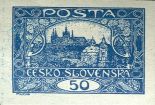- Poštovní muzeum Praha
- Poštovní muzeum Vyšší Brod
Poštovní muzeum Praha
Máte rádi poštovní známky? Pražská expozice Poštovního muzea je věnována zejména jim. Uvidíte filatelistické skvosty i rarity z celého světa a uvědomíte si, že mnohé jsou nejen odrazem své doby a země, ale také malými uměleckými skvosty. Hloubaví uvítají služby knihovny a badatelny.
Navštivte sídlo Poštovního muzea, umístěné v barokním domě ze 17. století, který je součástí pražské památkové rezervace UNESCO.
Adresa
Poštovní muzeum
Nové mlýny 2
110 00 Praha 1
Tel.: + 420 954 400 394
e-mail: postovni.muzeum@cpost.cz
Otevírací doba
- Denně kromě pondělí
- 9.00 – 17.00 hod.
Jak se k nám dostanete?
Poštovní muzeum se nachází na pravém břehu Vltavy v centrální části Prahy (ulice Nové mlýny) a je dobře dostupné prostřednictvím pražské integrované dopravy.
Vzdálenost od nejbližší stanice metra B Náměstí Republiky je cca 5 min. K dopravě je však možno využít i tramvajové spoje číslo 5, 14, 8 a 26, které staví v Revoluční třídě.
Upozornění: Expozice Poštovního muzea není bezbariérová.
Vstupné
Základní vstupné
Vstup do expozic 50,- Kč
Doprovodné akce PM včetně vstupu do expozic (doprovodné programy pro školní skupiny, komentované prohlídky, výtvarné dílny, apod.)
Snížené vstupné
Děti od 6 let, studenti, senioři
Doprovodné akce PM pro děti do 6 let 20 Kč
Vstup do knihovny v PM
Držitelé karty Senior pas sleva 20% ze základního vstupného
Vstup zdarma
Děti do 6 let
Doprovod školních skupin
Držitelé karty AMG ČR, NPÚ, ICOM a Svazu muzeí na Slovensku
Zaměstnanci České pošty po předložení průkazu
Co uvidíte
- stálá expozice poštovních známek České republiky a Československa včetně obálek prvního dne (FDC), filatelistických unikátů a padělků
- nejstarší známky evropských i mimoevropských zemí, známky OSN
- specializované sbírky známkové tvorby – Hradčany, ruská zemstva, klasické rakouské poštovní známky do roku 1918, staroněmecké státy do roku 1871 aj.
- předznámkové dopisy, otisky razítek, první novinové známky světa
- příležitostné výstavy známkové tvorby a historie poštovnictví
- knihovna a badatelna filatelistické a poštovněhistorické literatury
- původní měšťanský interiér z poloviny 19. století – čtyři salonky s nástěnnými malbami Josefa Navrátila
![Poštovní muzeum [logo]](/PostMuzeum-theme/images/muzeum/logo_postovni-muzeum.png)







